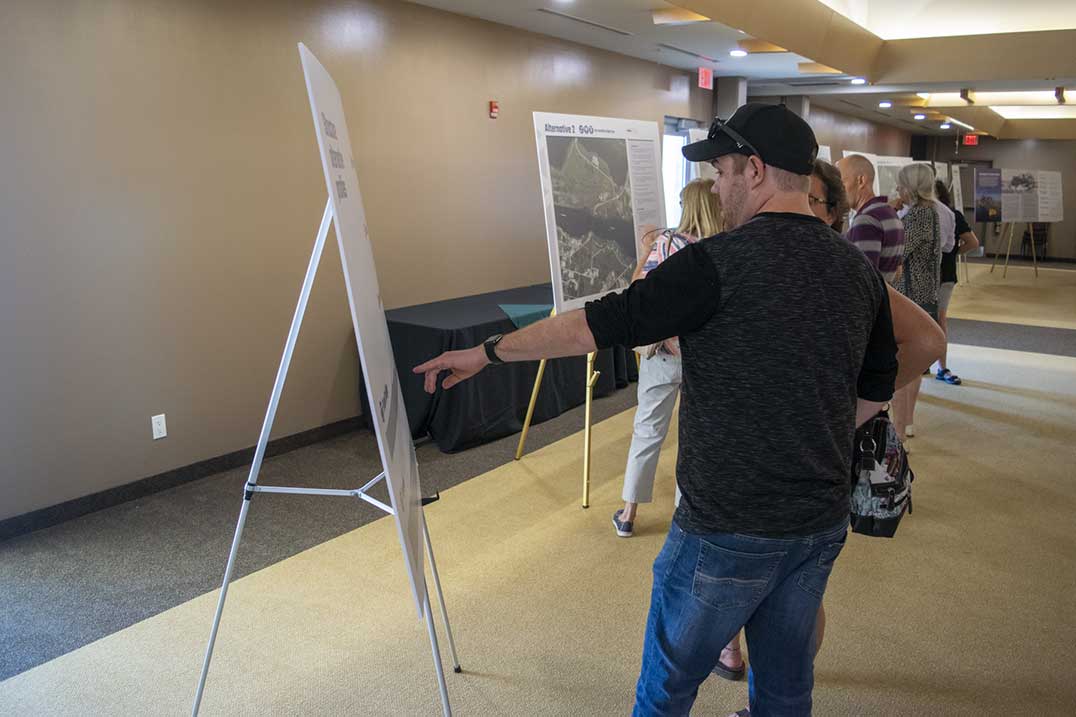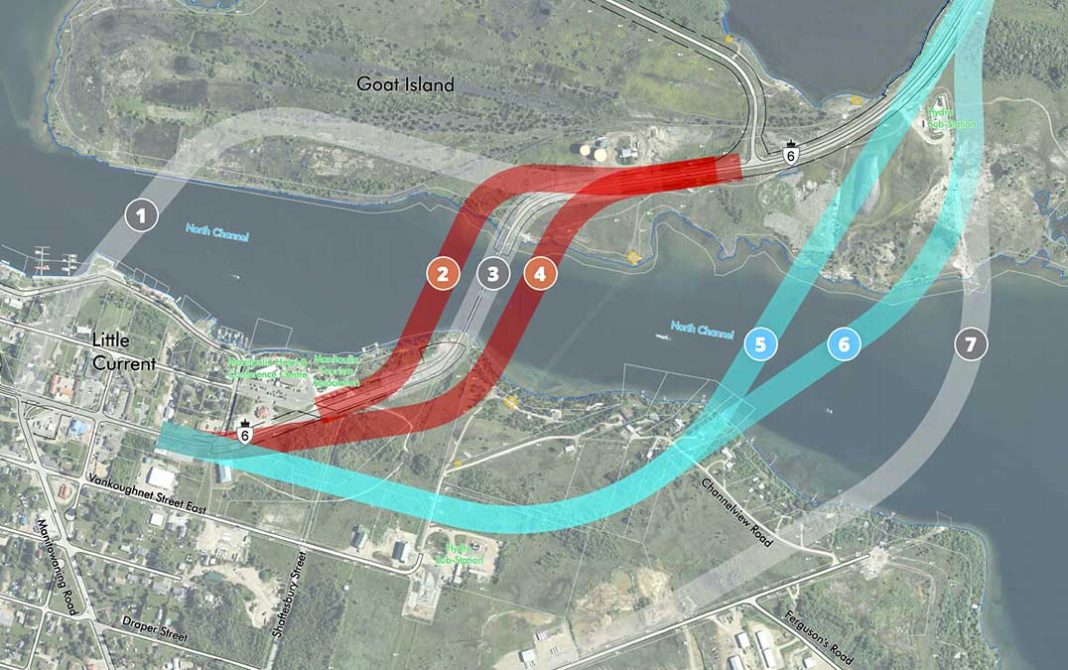LITTLE CURRENT – The days of the 106-year-old swing bridge in Little Current as a transportation link are officially numbered, according to engineers and government officials who spoke during the latest round of public consultation meetings about future road access between Manitoulin Island and the North Shore.
The public was invited to learn about the proposed alternatives to the existing swing bridge at an information centre held at the Manitoulin Hotel and Conference Centre last Wednesday, July 17. Members of the project team representing the Ontario Ministry of Transportation (MTO) and Stantec Consulting Limited were there to answer questions.
The aging structure is well beyond its expected serviceable life and is showing signs of falling into disrepair. Breakdowns this summer and last have caused minor traffic snarls and the steel structure is beginning to perforate.
Stantec consultant project manager Gregg Cooke spoke to Northeast Town council at its meeting the night before the public event to offer town officials a preview of the information. Noticeably absent was the “do nothing” option of continuing to invest money into the existing structure, something that was still an option during the first round of consultations.
“As a long-term solution, (do nothing) is not being carried forward because it doesn’t meet the study objectives,” Mr. Cooke told council. He did, however, acknowledge the historical nature of the bridge and said it was undergoing a separate study to assess its heritage value.
A ferry was also an option in the first round of the study, but had been removed before this second consultation period. All options going forward will accommodate two lanes of traffic.
“We’ve heard lots of comments on the alternatives. Some people prefer a fixed structure, some prefer mobile ones. We’ve also heard a lot about access,” he said, referring to a new road alignment which will be required for all of the crossing options. A new structure cannot be built in the same spot as the current swing bridge because that link, the only road access to the North Shore, must remain open to traffic during construction.
Building a new structure would improve traffic flow and access for all users, reduce operating and maintenance costs and improve the reliability of the crossing.
Public input on the first phase revealed the following priorities for Islanders: tourism/heritage, business impact with road relocation, cost, impact to the natural environment and aesthetics.
The five options that remain in consideration for the eventual replacement are briefly described in the front page companion story, ‘Five options for swing bridge replacement.’ A future step in the study process will be adding weights to the advantages and disadvantages of each crossing design to help determine which option is right for this project.
For the heritage aspect of the old swing bridge, the Ministry of Tourism, Culture and Sport has several prescribed bridge conservation options. The options in consideration include keeping the old bridge with a sympathetically designed new structure nearby (see the swing bridge option on the front page); keeping the existing bridge in place, adapted for new uses but not for roadway use; keeping the bridge as a heritage monument for viewing purposes only; relocating the bridge to a new site for continued or adapted use; or removing and replacing the bridge with a sympathetically designed structure.

Considering the increasing problems and costs in keeping the old bridge swinging, any heritage plans that would require it to turn, such as keeping it as a pedestrian-only crossing, are not likely to occur.
Councillor Barb Baker asked whether all potentially impacted property owners had been contacted. Mr. Cooke advised her that as many as possible had been sent letters and, in the case of seasonal property owners, they attempted to track down their permanent addresses to contact them.
Councillor Jim Ferguson asked why the ‘do nothing’ option was struck from the list. Mr. Cooke stated that the 106-year-old steel was becoming perforated and that, at some point, a permanent solution would be necessary. Councillor Ferguson asked whether it could be rebuilt in sections.
“I guess anything’s possible, but it becomes a matter of what is feasible,” said Mr. Cooke. “If there’s a strong desire to maintain the swing bridge, you can build a replacement, and you could build it with features like two lanes and a bike path.”
Councillor Mike Erskine asked about the estimated end of service date for the current structure. Mr. Cooke said it should have been expected to last 75 years; however, there was no specific date when the bridge must be taken out of service.
Northeast Town Mayor Al MacNevin said the township’s primary concern, which they had expressed during the first phase of the project, was the impacts to businesses. He said that option two, a movable bridge immediately west of the current span, was the only viable option to keep business traffic intact.
Mayor MacNevin expressed his concern that people not living in the area year-round and those who do not read The Expositor regularly may be unaware of the property impacts of the proposed road alignments. He also stressed the importance of contacting property owners not immediately along the proposed crossing routes, since having a 30-metre high bridge even down the street from one’s property would come with significant impacts.
More than 100 people attended the public information session the following day. MTO senior environmental planner Andrew Healy said there had been interest in all of the options to varying degrees. Attendees expressed concerns about diverting traffic from the business area of town, something the study partners had tried to mitigate in their proposed alternatives.
“We’re really trying to flesh out what issues people have with the other alternatives, and we’ll consider that feedback in the evaluation process. We’re also looking for feedback on the evaluation criteria so people can share what’s most important to them,” said Mr. Healy.
Stantec’s Nevena Gazibara added that the study will be underway for another year before the recommended plan is brought forward.
“All the displays here are available on our website and comments are still welcomed,” she said.
Gore Bay Mayor Dan Osborne, who was at the event, said seeing the proposed routes all connecting back to Highway 6 near Little Current’s core allayed some of his fears about business impacts.
“A lot of people seem concerned about the visual impacts, but you can see the windmills all the way from Kagawong and there’s those hydro lines there too,” said Mayor Osborne. “My preference would be an over or under fixed crossing. There would be a benefit for everyone.”
Little Current’s Carman Ferguson was also at the information session and was in favour of a fixed crossing, though he acknowledged that the property owners along the proposed connection route may be dissatisfied with that plan.
“People may think they don’t like the looks (of an overhead bridge) because they’re used to the swing bridge, but to me, you’re done with mechanics, either swinging or lifting. I suppose you’d get used to it,” said Mr. Ferguson.
“You can’t stand in the way of progress. It’s not just about Little Current, all of Manitoulin is concerned with moving traffic more efficiently,” he said.
The information sessions circulated to area First Nations after the Little Current meeting, with that tour wrapping up tomorrow, July 25. Public comments are still welcomed through the study’s website on an ongoing basis. Further information about the study can be found at: SwingBridgeStudy.ca





